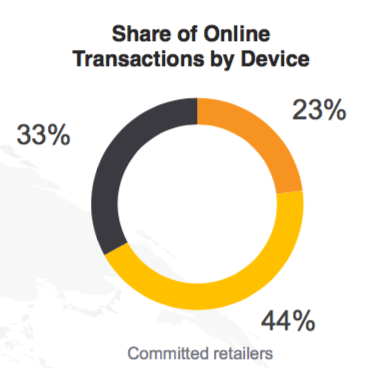Retailers with shopping apps now see majority of ecommerce sales from mobile
E-commerce is now a truly cross-device experience.

For many retailers, mobile traffic equals or exceeds desktop traffic. Now, according to Criteo’s latest commerce report (Q4 2017), mobile sales represent the majority of total ecommerce for retailers with successful shopping apps.
Retailers that have both mobile sites and apps are seeing, on average, two-thirds of their online sales coming from mobile devices, according to the report. In the chart below, black is desktop sales, orange is mobile web and yellow is app-based sales.

As you might expect, conversion rates on mobile apps are higher, roughly 3x greater than on the mobile web. This may be because the user experience is better in apps, including the checkout process. But it may also partly be because those who download and use retail apps are more loyal and inclined to buy from those retailers in the first place.

Those most mobile commerce transactions happen within apps, Criteo said that more than a quarter (26 percent) of all desktop transactions were preceded by a mobile click. More broadly, 41 percent of desktop conversions were influenced by or began on another device.

Criteo explains that “retailers with low mobile sales get more cross-device transactions.” This may be because the mobile experience is poor and determined buyers are moving to the desktop to complete the intended purchase. But there’s also probably some “leakage” or lost sales as a result of that cross-device leap.
The report also argues for combining cross-device and offline data to improve targeting and efficiency. And it points out that so-called omnichannel shoppers have greater lifetime value and drive a higher percentage of sales than other customers.

This makes logical sense but again hints at a bit of a chicken-and-egg issue: Do they spend more across platforms because they’re more loyal to begin with, or does a successful omnichannel experience encourage more loyalty and spending?
Opinions expressed in this article are those of the guest author and not necessarily MarTech. Staff authors are listed here.
Related stories
